 Browns Archive
Browns Archive  Top Cleveland Sports Figures, By the Numbers. #42
Top Cleveland Sports Figures, By the Numbers. #42
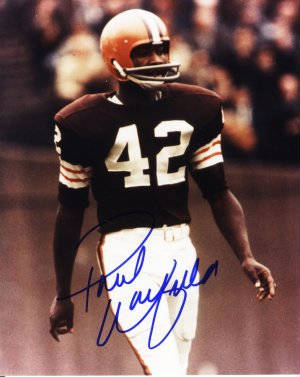 This is one installment in a team effort by The Cleveland Fan, highlighting the top local sports figures by jersey number. Please feel free to weigh in with your thoughts, in the Boards. As David Letterman would say, “For entertainment purposes only; please, no wagering.”
This is one installment in a team effort by The Cleveland Fan, highlighting the top local sports figures by jersey number. Please feel free to weigh in with your thoughts, in the Boards. As David Letterman would say, “For entertainment purposes only; please, no wagering.”
October 15, 1973. The 3-1 Cleveland Browns were playing host to the defending Super Bowl champions, the Miami Dolphins. It was Monday night.
Monday Night Football was in its relative infancy. In the four seasons since its Cleveland debut, the weekly outpouring of hype and emotions surrounding the NFL showcase was frenzied, and unforced.
The fervor on this night seemed a bit more intense than normal. It began to culminate as the PA announcer issued the pregame introductions for the Dolphins. The home crowd dutifully heaped a cascade of boos over them- until it was Paul Warfield’s turn.
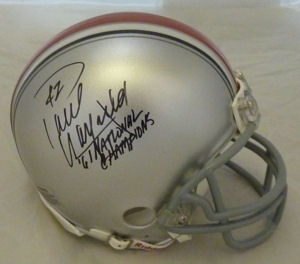
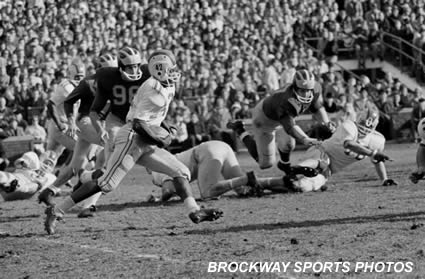 That was when the throng rose to its feet, with a prolonged standing ovation for the star receiver out of Warren and Ohio State. This was their first chance to show their deep appreciation for his six years as a standout performer for their Browns. Miami coach Don Shula (himself from Grand River and Harvey High School) was compelled to approach Warfield, and he commented on the remarkable tribute. Warfield would later recount the moment as one of his career highlights.
That was when the throng rose to its feet, with a prolonged standing ovation for the star receiver out of Warren and Ohio State. This was their first chance to show their deep appreciation for his six years as a standout performer for their Browns. Miami coach Don Shula (himself from Grand River and Harvey High School) was compelled to approach Warfield, and he commented on the remarkable tribute. Warfield would later recount the moment as one of his career highlights.
So how did the Ohio boy become a prominent fixture of a perennial Super Bowl powerhouse in Miami, Florida?
Paul Warfield graduated from Warren G. Harding High School back in 1960. He’d been a three year star running back and defensive back. He also set an Ohio long jump record while with the Harding track team.
At Ohio State, he was All-Big Ten twice, playing halfback and cornerback. His track career extended to his Buckeye years, as well, and he shined as a hurdler, 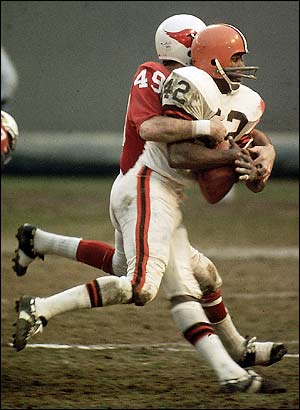 jumper and sprinter.
jumper and sprinter.
By 1964, Cleveland Browns patriarch Paul Brown was a little over a year removed from his firing as head coach of his team, at the hands of owner Art Modell. Modell was the brash, young, attention-loving ad executive who had borrowed to the maximum to purchase the franchise. Although Modell had won the power struggle, Paul Brown was still under contract. His role had shifted to team consultant, which consisted of making personnel recommendations. He advised the Cleveland Browns to select Paul Warfield in the 1964 NFL draft.
The Browns’ head coach by now was one-time Paul Brown protégé Blanton Collier. Collier was a quiet, player-friendly type, whom football historians acknowledge as vastly underrated in his coaching ability. Paul Brown saw Warfield as a defensive back of the future for the team. Collier agreed: he’d been a two-way player as a Buckeye, but was known primarily for his defensive play.
Warfield was taken by the Browns with their first round pick, number 11 overall. For a team that boasted fullback Jim Brown and perhaps the finest offensive line in football, it began to appear to be a case of the “rich getting richer.”
That 1964 draft sent eleven Hall of Fame players to the NFL, more than any other draft in history:
Charley Taylor, halfback from Arizona State University taken 3rd overall by the Washington Redskins.
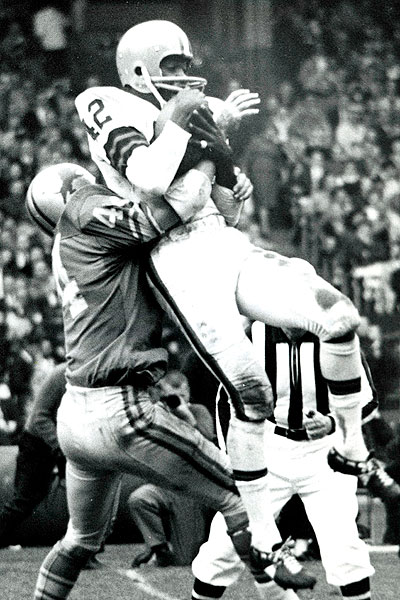 Roger Staubach, quarterback from Navy taken in the 10th round, 129th overall by the Dallas Cowboys.
Roger Staubach, quarterback from Navy taken in the 10th round, 129th overall by the Dallas Cowboys.
Leroy Kelly, running Back from Morgan State taken in the 8th round, 110th overall by the Browns.
Mel Renfro, cornerback from Oregon taken in the 2nd round, 17th overall by the Dallas Cowboys.
Paul Krause, safety from Iowa taken in the 2nd round, 18th overall by the Washington Redskins.
Dave Wilcox, linebacker from Oregon taken in the 3rd round, 29th overall by the San Francisco 49ers.
Bob Brown, offensive Tackle from the University of Nebraska–Lincoln taken in the 1st round, 2nd overall by the Philadelphia Eagles.
Carl Eller, defensive End from the University of Minnesota taken in the 1st round, 6th overall by the Minnesota Vikings.
Bob Hayes, wide Receiver from Florida A&M taken in the 7th round, 88th overall by the Dallas Cowboys.
Bill Parcells, offensive tackle from Wichita State University taken in the 7th round, 89th overall by the Detroit Lions (inducted as a coach).
There were only 14 teams in the NFL in 1964. Thus, two rounds of draft picks then roughly equaled one round today.
Shortly after the draft, Coach Collier held a spring practice session at Lakewood High School. Unofficially, it was the first NFL minicamp, ever. Paul Warfield spent much of the day with the defensive unit. Before the day was over, the Browns’ coaches asked him to line up on offense, just to see how he looked on that 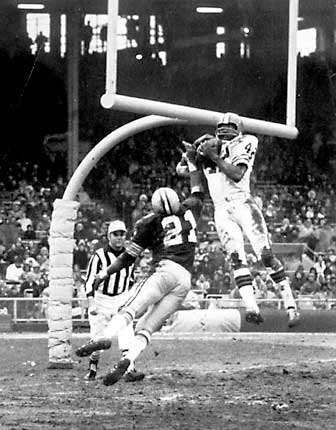 side.
side.
On one passing play, Collier and offensive coordinator (and ex-Browns player) Dub Jones observed Warfield’s natural talent as he made a play against a defender. As Warfield related later, Collier said, “That’s it. You’re a receiver.”
At training camp at Hiram College that fall (about a 20 minute drive from where he grew up), Warfield was taken under the wing of long-time Browns receiver Ray Renfro. Warfield had the speed, hands, and perhaps to an underrated extent, physical strength. But he credits Renfro with helping him with the mental game, with insights and anticipation of events that occur on the field. He insists the mental aspect is what separates the good players from the great.
Cleveland fans know that 1964 was the last championship season for the Browns- or any Cleveland franchise. It is burned into their brains, and handed down from generation to generation (to generation). It was a season in which the Browns were favorites to play in the December title game. Paul Warfield was a rookie in 1964, and he began to make his mark as a receiver and a kick returner.
His first significant contribution came in the 28-20 victory at Philadelphia. Jim Brown ran for 104 yards in that game, and beat the Eagles linebackers on a 40 yard catch and run for a touchdown. Warfield accounted for 97 of quarterback Frank Ryan’s remaining 153 yards passing, on six catches. One connection was for 24 yards and a touchdown.
The next week represented the Cleveland Stadium coming out party for Paul Warfield. On a day the Browns beat the Dallas Cowboys to move to 3-0-1, Warfield “leaped and danced” (in the words of the Plain Dealer account) for 123 yards, on five catches. The back breaker was a 40 yard touchdown pass in the third quarter. On a second-and-seven play, Warfield was in double coverage. He was able to shake free, and caught the ball at about the five yard line on his way to the score.
Warfield suffered a couple nagging leg injuries in 1964. Still, he was able to battle through those enough to continue to contribute to the cause. He caught a 62 yard touchdown at home to help the Browns sweep the Washington Redskins, to improve their record to 7-1-1. He also nabbed a TD the following 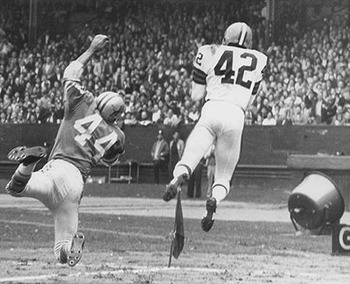 week, in a home win vs. the Detroit Lions. The Browns lost at Green Bay in Week 11, but Warfield had a great day. He caught two touchdown passes from Ryan, for 48 and 19 yards. He had the defense beat all day. Uncharacteristic errors by the Browns added up to the loss.
week, in a home win vs. the Detroit Lions. The Browns lost at Green Bay in Week 11, but Warfield had a great day. He caught two touchdown passes from Ryan, for 48 and 19 yards. He had the defense beat all day. Uncharacteristic errors by the Browns added up to the loss.
Warfield had another big day at St. Louis, with six catches for 91 yards. He had a great fourth quarter. Unfortunately, that game was the Browns’ second loss in three weeks, and some concern was growing among the fans and media.
All that was forgotten the next week, after a 52-20 crushing of the Giants in New York. That game clinched the NFL Eastern Division- their first since 1957. There were several stars of that game. Paul Warfield pitched in as the Browns’ leading receiver, with five catches for 103 yards. He caught an eight yard touchdown pass in the third quarter, and had wowed observers near the end of the first half with a great catch for 47 yards that put the ball at the Giants’ one yard line. The Browns would punch it in from there.
As we well know, the Browns would shut out the powerhouse Baltimore Colts two weeks later, for the NFL Championship. They had been underdogs, but played like the favorite. They removed all doubt as to the outcome in the third quarter, when their ball control offense took over after the defense had stifled Johnny Unitas and company all afternoon.
In the years following 1964, the Browns enjoyed several strong seasons. In 1968, veteran quarterback Bill Nelsen was acquired in a trade with the Pittsburgh Steelers. (Browns fans have been buzzing over the fact that this was the most recent trade between Cleveland and Pittsburgh, until the 2013 NFL draft day 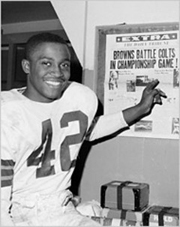 trade.) Nelsen took over for Frank Ryan, and showed tremendous leadership in leading the Browns to several big wins. Inconsistency was a problem, however, and nobody was sure how long Nelsen’s old, beat up knees would last. The team was doing well overall, but Cleveland needed a quarterback of the future.
trade.) Nelsen took over for Frank Ryan, and showed tremendous leadership in leading the Browns to several big wins. Inconsistency was a problem, however, and nobody was sure how long Nelsen’s old, beat up knees would last. The team was doing well overall, but Cleveland needed a quarterback of the future.
Warfield says Art Modell informed him, in person. He’d been traded to the Miami Dolphins, for their first round draft pick (#3 overall; the #1 pick was Terry Bradshaw to the Steelers). It was a shock, to Warfield and to the fans.
With the pick, Modell selected All-American quarterback Mike Phipps out of Purdue (he had been the immediate replacement at Purdue for Dolphin quarterback Bob Griese). Phipps’ career had some bright spots, but he is universally seen as an NFL bust. He had some truly awful stretches as the Browns’ quarterback. Phipps was traded after the 1976 season, paving the way for backup Brian Sipe’s run with head coach Sam Rutigliano.
Paul Warfield’s five seasons in Miami enhanced his status as an NFL Hall of Famer. He was an integral part of the Dolphins’ three Super Bowl seasons in the ‘70s (they won two, with a perfect season as well). The Dolphins famously ran the ball, with Jim Kiick, Stow’s Larry Csonka, and Mercury Morris, but Warfield was a dangerous scoring option via the pass.
His statistics while in Cleveland were nothing to sneeze at. Examples: he ranks sixth on the team’s all-time receiving yards list, and second in postseason yards. He was a Pro Bowler in his rookie season of 1964, and also in 1968 and 1969.
After the 1974 Super Bowl, Warfield, Kiick, and Csonka signed contracts to play in the upstart World Football League. This stunned the NFL, and opened the door for the likes of the Pittsburgh Steelers and the Oakland Raiders. By 1976, Paul Warfield was back in the NFL- finishing out his career with the Cleveland Browns.
Warfield was a sports news anchor in Cleveland, shortly after his retirement. He is currently retired, and occasionally adds to his countless appearances, both in Cleveland and in Columbus.
He’s our guy. We love Paul Warfield, #42.
For this article, I relied pretty heavily on the Cleveland.com game story database, Tales from the Browns Sideline by Tony Grossi, and Wikipedia.
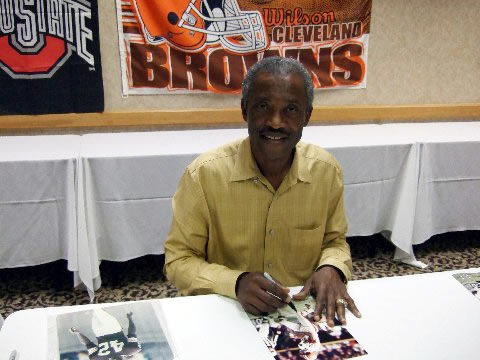
- NBA Announces 2013-2014 Schedule
- Browns Ink Sharknado
- Sharknado A No-Show For Rookie Camp
- Trent Richardson Out Until Training Camp
- Browns Sign Brandon Jackson
- Carrasco Suspended Eight Games
- Browns Add to Wide Receiver Depth with David Nelson
- Browns Need to Learn from Past Draft Mistakes
- Browns Release Chris Gocong and Usama Young
- Browns Missing on Grimes Disappointing, But Not The End
The TCF Forums
- Official- Browns Coach Search/Rumors
mattvan1 (Tuesday, January 21 2014 1:19 PM) - Movies coming out
rebelwithoutaclue (Tuesday, January 21 2014 12:56 PM) - 2015 Recruiting
jclvd_23 (Tuesday, January 21 2014 12:38 PM) - The 2014 Offseason Thread
Larvell Blanks (Tuesday, January 21 2014 12:25 PM) - Chris Grant's first 3 drafts
Kingpin74 (Tuesday, January 21 2014 10:13 AM) - Mike Brown
YahooFanChicago (Monday, January 20 2014 11:15 PM) - 2014 Hoops Hockey Hijinx
jpd1224 (Monday, January 20 2014 4:44 PM) - 2014 Recruiting
jclvd_23 (Monday, January 20 2014 2:26 PM) - Wish List - #4 Pick
Hikohadon (Monday, January 20 2014 1:26 PM) - #1 overall pick Anthony Bennett
TouchEmAllTime (Sunday, January 19 2014 1:28 PM)


